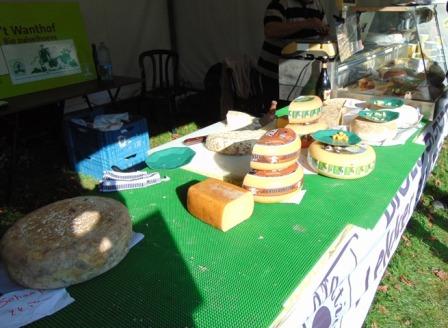There are fresh cheese (also called cottage cheese,) and ripened cheeses.
Cheese consists mainly of the solid particles that are present in the milk, namely, protein and fat.
To make 1 kg of cheese do you need approximately 10 liters of milk. After the pasteurization there is added lactic starter and / or rennet to it.
 In cheese making, we must bind the solids in milk, and separate them from the liquid.
In cheese making, we must bind the solids in milk, and separate them from the liquid.
The first step in the manufacture of cheese is the precipitation of casein, the solids from milk. This can happen in two ways:
by lactic acid bacteria to produce enough lactic acid in such a way that casein flocculates, or
by adding rennet to the milk (at pH 6.8).
Pour the now sour milk through a cloth. Hang on and let the water drip out. This fresh cheese (made with rennet) is called cottage cheese, fresh cream cheese, Mozzarella, Feta ...
Starter
Lactic acid (sour milk, buttermilk, whey) is a harmless bacterial culture that gives the cheese a delicious taste and ensures a longer shelf life for the cheese.
Rennet ensures that the ’hard’ materials clump together in the milk.
In order to promote the coagulation also natural calcium salt (calcium chloride) is used. The milk is heated (softly, bain-Marie (in waterbath)) to 30-31°C.
Add more lemon juice or a little vinegar as the whey not separates from the cheese.
After the curdling the largest part of the fluid milk, the whey, forms and creates the curd, that becomes cheese by further ripening.
The thick, the curd is cut into pieces so that the solids (curds) separate from the liquid (whey). The smaller the pieces, the harder the cheese. Wringing the curd too hard would press the fat from the cheese, too little twist creates pinch cheese: hollow cracks in the cheese. (You can hear them when you knock on the crust.)
Press the cheese with 3 (up to 6) times its own weight for 4 hours. The first half hour you press with
half its own weight. Let stand covered for 10 hours.
Morning cheese matures faster and firmer. Cheese of the morning milking is around 4-5 hours under the press.
A cheese of 5 kilograms was 2.5 to 3 days immersed in a brine bath. A cheese of 20 kilograms twice as long. The supernatant side is sprinkled with salt.
This is followed by cutting, pressing, curing and aging.
Brine the cheese in a saline solution (4 kg of salt in 18 liters of water) for 12 hours, dry them
with a clean cloth and place them on a wooden shelf in a cool, dry place. Turn the
cheeses regularly. Any mold on the cheese you wipe with a clean cloth with vinegar.
Ripening can now begin. Save best on 12 to 15⁰C.
Inadequate hygiene can occur gas releases in the cheese. He sounds hollow when tapped.
Young cheese has about 5 weeks maturation,
young mature cheese you get after about 8 weeks,
mature cheese after 16 weeks,
extra mature after 7 months
and old cheese is only ready after a whole year ripen.
The Romans also made cheese from milk of horses, asses, camels, deer, hares and rabbits!
The tomb of Ptahmes, who was burgomaster of Memphis thirteen centuries BC, was excavated in 1885 but disappeared again by sandstorms. It was rediscovered in 2010. In this Egyptian tomb, the oldest form of hard cheese (3,300 years) was found. It was made with cow's milk and milk from a sheep or goat.
"What happens to the holes when the cheese is eaten ?" (Bertolt Brecht)
'Cheese: mature milk ." (Richard Condon)
